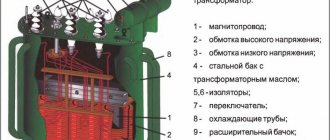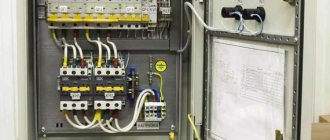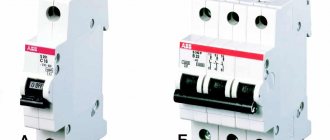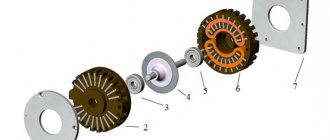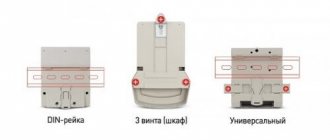The most common electrical devices in industry and everyday life are transformers. Their purpose is to transfer power within an unmatched electrical circuit between its various circuits. They are used in cases where it is necessary to lower or increase the voltage between the energy source and the consumer. Transformers are also included in power supply circuits that convert alternating current into direct current. The operation of transformers is based on their ability to transmit electricity between circuits through magnetic induction.
Three-phase power transformer with cast insulation TSL (TSGL) and TSZL (TSZGL)
Three-phase power transformer TS and TSZ
High-voltage discrete transformer-stabilizer VDT-SN
Power transformers are electromagnetic devices designed to convert alternating current voltages while maintaining its frequency, as well as to transform the power supply system itself.
Design and arrangement of power transformers
The main part of each power transformer is its core with several windings, made of ferromagnetic material. As a rule, these are thin sheets of special transformer iron with soft magnetic properties. The sheets are laid in such a way that the cross-sectional shape of the rods under the windings is close to a circle. To increase the efficiency of the device and reduce losses, entire sheets cover the joints between individual plates.
The transformer winding is usually made of copper wire with a rectangular or round cross-section. Each turn is isolated from the magnetic core itself, as well as from neighboring turns. For coolant circulation, technical voids are provided between the windings and its individual layers.
Each transformer has at least two windings: primary (electric current is supplied to it) and secondary (current is removed after converting its voltage).
Transformer core fastening
| Figure 5. Transformer with a core held together by pads | Figure 6. Transformer with a core held together by stamped covers |
In low-power power transformers, two main methods of attaching the assembled core package are used.
Fastening with studs
In this case, the transformer core package is compressed using pins and brackets made of strip steel 1 - 2 mm thick (Figure 5).
In armored transformers, a part stamped from sheet steel is sometimes used to secure the core, which also serves as the transformer casing (Figure 6).
Fastening by pressing the core into the holder
In this case, the assembled transformer core package is crimped with a special clip.
The material for the core of a low-power power transformer is special sheet electrical steel grades E41, E11 and others with a sheet thickness of 0.50 and 0.35 mm. The main technical data of sheet steel of various grades are determined by GOST 802-58¹.
The designations, for example, of the indicated steel grades are deciphered as follows: E - electrical; the first digit 4 is highly alloyed (with a silicon content of up to 5%): the first digit 1 is lightly alloyed (with a silicon content of up to 1%); the second digit 1 – with normal specific losses.
To make a core from sheet steel, U-shaped plates are stamped for single-phase core transformers and W-shaped plates for single-phase armored and three-phase core transformers. If it is not possible to stamp shaped plates, rectangular plates are prepared by cutting sheets using scissors. Both when stamping and when cutting workpieces from steel sheets, it is desirable to make plates along the direction of steel rolling, since the magnetic permeability of steel in this direction is somewhat greater.
In order to reduce eddy current losses in the transformer core, the steel sheets are coated with an electrical insulating coating.
The production of twisted cores of low-power transformers (Figure 4) is made from cold-rolled steel grades E310 and E320 on special winding machines.
Principle of operation
The operating principle of any power transformer is the phenomenon of electromagnetic induction. An alternating current is supplied to the primary winding, which forms an alternating magnetic flux in the magnetic circuit. This occurs due to its short circuit on the magnetic circuit and the formation of adhesion between the windings, inducing an EMF. A load connected to the secondary winding produces voltage and current in it.
Structurally, to obtain any voltage on the secondary winding, the required ratio of turns between the windings is used. The power transformer has the property of reversibility. In other words, it can be used to both increase and decrease voltage. In most cases, a power transformer is used to solve certain problems. For example, specifically increase or decrease the voltage. In a step-up transformer, the voltage on the primary winding is lower than on the secondary.
Instrument transformers
In this class there are two types of devices that provide transformations for measuring network parameters:
- current
- voltage
Instrument transformers are created with a high class of accuracy. During operation, their metrological characteristics are periodically checked for the correctness of measurement of both the magnitudes and deviation angles of the current and voltage vectors.
Current transformers
The main feature of their device is that they are constantly operated in short circuit mode. Their secondary winding is completely short-circuited to a small resistance, and the rest of the structure is adapted for such work.
To eliminate emergency mode, the input power is limited by a special device in the primary winding: only one turn is created in it, which cannot create a large voltage drop across the winding when current flows through it and, accordingly, transmit high power to the magnetic circuit.
This turn cuts directly into the power circuit, ensuring its serial connection. For individual designs, a through hole is simply created in the core, through which a wire with primary current is passed.
The load of the secondary circuits of a current transformer under voltage must not be interrupted. For this reason, all wires and connecting terminals are manufactured with increased mechanical strength. Otherwise, high-voltage voltage immediately appears at the broken ends, which can damage the secondary circuits.
Thanks to the operation of current transformers, it is possible to provide constant monitoring and analysis of loads flowing in the electrical system. This is especially true for high-voltage equipment.
Instrument current transformers 110 kV
The rated values of secondary currents of energy instrument transformers are 5 amperes for equipment up to 110 kV inclusive and 1 A - higher.
Current transformers are widely used in measuring instruments. Due to the use of a sliding magnetic circuit design, it is possible to quickly perform various measurements without breaking the electrical circuit, which must be done when using conventional ammeters.
Current clamps with a sliding magnetic core of a current transformer allow you to grasp any conductor with voltage and measure the magnitude and angle of the current vector.
Voltage transformers
A distinctive feature of these designs is that they operate in a mode close to the idle state, when the value of their output load is low. They are connected to the voltage system whose value will be measured.
Voltage transformer 110 kV
Voltage measuring transformers provide galvanic isolation of equipment from primary and secondary circuits and operate in each phase of high-voltage equipment.
From them, entire complexes of measurement systems are created that make it possible to filter and isolate various components of voltage vectors, the accounting of which is necessary for the accurate operation of protections, interlocks, and alarm systems.
Due to the operation of current and voltage transformers, vectors of secondary quantities proportional to the primary quantities are removed in real time. This allows not only to create measurement and protection circuits for current and voltage, but also, through mathematical transformations of vectors, to analyze the state of powers and resistances in the existing electrical system.
Classification of power transformers
Depending on the voltage class and total power consumption, power transformers are conventionally divided into the following categories:
By power:
- Up to 100 kVA, up to 35 kV;
- 100 – 1000 kVA, up to 35 kV;
- 1000 – 6300 kVA, up to 35 kV;
- More than 6300kVA, up to 35kV;
- Up to 32,000 kVA, 35 – 110 kV;
- 32,000 – 80,000 kVA, up to 330 kV;
- 80,000 – 200,000 kVA, up to 330 kV;
- More than 200,000 kVA, more than 330 kV.
Classification of transformers by design parameters
The design parameters of a transformer determine the features of its core and windings. Several features can be identified that characterize various design features.
1. Type of construction . One of the most important design features that determines the type of transformer design. The determining factor here is the type of core, which can be defined as:
- armored core , has three rods, and the central rod is wider than the outer ones and the transformer windings are located on it, and the side ones serve only for the flow of magnetic flux;
— rod core , has two rods of the same width and the windings are placed evenly on them;
— toroidal core , made in the form of a toroid with a rectangular or (less often) circular cross-section and the windings are distributed evenly throughout the core.
In accordance with the type of core, transformers also have the following names: armored , rod and toroidal transformers , respectively. Each type has its own characteristics that must be taken into account when designing a transformer.
Types of transformer cores: armored, rod and toroidal.
2. Type of core . This feature characterizes the manufacturing technology of transformer cores. The following categories can be distinguished:
— laminated cores or stacked cores. Lashing is the assembly of a transformer core from stamped plates of one configuration or another. The configuration of stamped plates is accordingly: W-shaped, U-shaped, E-shaped and O-shaped. However, due to the low technology of stamping plates for high-power transformers, a different type of core is used;
Laminated (stamped) cores.
- tape cores . Cores of this type are formed from bent sections of tape or wound on machines. Depending on the principle of assembly of the transformer, there are closed, detachable and split. Structurally, strip cores differ from laminated ones only in the presence of rounded corners;
Tape cores.
- pressed cores . In accordance with the name, such cores are made by pressing from powder materials, both halves of the core and its solid version. The need for pressed cores arose due to the need to use ferrite powder materials as magnetic cores of appropriate designs. Since pressing can be done to almost any shape, core shapes are available in many configurations.
Pressed ferrite cores.
3. Cooling methods . These signs determine the method of heat removal from an operating transformer:
— transformers with natural cooling ;
— transformers with forced air flow;
— transformers with liquid cooling ;
— transformers with vapor-liquid cooling ;
4. Methods of insulation and protection . These features determine ways to protect transformers from external influences and environmental factors:
— dry open transformers . Protected from external influences only by insulation of winding wires, interlayer insulation and winding frame;
Dry open transformer series EI.
— closed sealed transformers . Such transformers are characterized by increased performance characteristics that are resistant to harsh operating conditions (dirt, dust, mechanical stress, etc.);
Sealed transformer TPK-2.
— tropical-resistant transformers . The protection of this type of transformer is characterized by special resistance to harsh operating conditions in areas with tropical climates.
Tropical-resistant transformer T0.5-27.
Types of power transformers
Power transformers can be divided into several types based on the following characteristics and indicators:
- Cooling type. There are dry and oil transformers. The first option is air-cooled and is used where environmental and fire safety requirements are increased. The second option is a housing filled with oil with dielectric properties, into which a core with windings is immersed;
- Climatic design: external and internal options;
- Number of phases. There are three-phase (the most common) and single-phase;
- Number of windings. There are two-winding and multi-winding options;
- Purpose: increasing and decreasing.
An additional criterion is the presence or absence of an output voltage regulator.
Design of coils of low-power transformers
The coils of low-power transformers with windings of small-diameter wires are usually made in the form of a frame on which the windings are wound. The coil frames are usually made of insulating material or by stamping from plastic (Figure 7), or glued from electrical cardboard, textolite, getinax and other materials (Figure 8).
| Figure 7. Transformer coil frame stamped from plastic | Figure 8. Prefabricated transformer coil frame |
Power transformer elements
The design of a power transformer implies the presence of the following elements:
- Power inputs are devices through which the load is supplied. Can be located inside the product or outside. The bushings are insulated with various special materials and differ in the type of insulation and design;
- Coolers. For powerful power transformers, an oil cooling system is provided. Cooling of the oil itself is carried out using radiators, a corrugated tank, forced ventilation, oil-water coolers or circulation pumps;
- Output voltage regulators are devices designed to change the transformation ratio. They can operate both under the influence of a certain load and without it (depending on the design). Essentially, regulators add or reduce the number of turns in the winding.
Power transformers can be equipped with additional attachments:
- Gas relay is a device with a protection function. If the transformer is unstable, the oil decomposes into its components, releasing gas. The gas relay either turns off the transformer or notifies with warning signals;
- Temperature indicators – sensors that measure oil temperature;
- Desiccant absorbers are devices that absorb condensation formed under the protective cover, thereby preventing it from entering the oil;
- Oil regeneration system;
- Automatic coolant pressure increase protection system;
- Oil level indicator.
Transformer operation testing technology
The quality of the device is checked using a multimeter. Turn-to-turn short circuit is a common fault. It is also necessary to monitor changes in the external characteristics and smell of the product. The varnish coating serves as an insulating material during the walk, after damage to which the temperature in the problem area rises due to the persistence of resistance. Serviceable products do not have blackening, drips or swelling.
The paper should not be charred and there should be no burning smell. The winding resistance can be determined from a reference book if the type of device is known. The data obtained after measurement using a multimeter is compared with the information in the reference book. Coils are considered faulty if the difference between the indicators exceeds 50%. If the resistance of the windings is unknown, you need to use the number of turns, cross-section and material from which the wire is made when making calculations.
Power transformer parameters
- Rated power. For a transformer with two windings, the parameter is equal to the power of each of them. For a three-winding version with different power windings, the parameter is equal to the larger of the indicators;
- The rated voltage of the windings is a characteristic parameter for no-load operation;
- Rated current is an indicator at which long-term operation of the device is permitted;
- Short circuit voltage is a characteristic of the impedance of the windings.
- Short circuit losses;
- No-load current – losses of magnetic core material (reactive and active);
- No-load current losses;
- Transformation coefficient.
Transformers: their purpose and classification
Energy conversion in a transformer is carried out by an alternating magnetic field using a magnetic core. The voltages of the primary and secondary windings are usually not the same. If the primary voltage is less than the secondary, the transformer is called a step-up, if it is more than the secondary, it is called a step-down. Any transformer can be used both as a step-up and step-down transformer. Step-up transformers are used to transmit electricity over long distances, and step-down transformers are used to distribute it between consumers. Depending on the purpose, there are power transformers, voltage measuring transformers and current transformers. Power transformers
convert alternating current of one voltage into alternating current of another voltage to supply consumers with electricity.
Depending on the purpose, they can be increasing or decreasing. In distribution networks, as a rule, three-phase two-winding step-down transformers are used, converting voltages of 6 and 10 kV to a voltage of 0.4 kV. (The main types of transformers are TMG, TMZ, TMF, TMB, TME, TMGSO, TM, TMZH, TDTN, TRDN, TSZ, TSZN, TSZGL and others.) Voltage measuring transformers
are intermediate transformers through which measuring instruments are switched on at high voltages.
Thanks to this, the measuring instruments are isolated from the network, which makes it possible to use standard instruments (with their scale re-graded) and thereby expands the limits of the measured voltages. Voltage transformers are used both for measuring voltage, power, energy, and for powering automation circuits, alarms and relay protection of power lines from ground faults. In some cases, voltage transformers can be used as low-power step-down power transformers or as step-up test transformers (for testing the insulation of electrical devices). The following types of voltage transformers are presented on the Russian market: 3NOL.06, ZNOLP, ZNOLPM, ZNOL.01PMI, 3xZNOL.06, 3xZNOLP, 3xZNOLPM, NOL.08, NOL.11-6.O5, NOL.12 OM3, ZNOL.06- 35 (ZNOLE-35), ZNOL 35, NOL 35, NOL-35 III, NAMIT-10, ZNIOL, ZNIOL-10-1, ZNIOL-10-P, ZNIOL-20, ZNIOL-20-P, ZNIOL-35, ZNIOL-35-P, ZNIOL-35-1, NIOL -20, NIOL-35, NOL-SESH -10, NOL-SESH -10-1, NOL-SESH-6, NOL-SESH-6-1, NOL- SESH-20, NOL-SESH-35, 3xZNOL-SESH-6, 3xZNOL-SESH -10, NALI-SESH-10, NALI-SESH-6, NTMI 6, NTMI 10, NAMI 6, NAMI 10, NAMI 35, NAMI 110, ZNAMIT-6, ZNAMIT-10, ZNOMP 35, NOM 6, NOM 10, NOM 35, NKF 110, NKF 150, NKF 220 and others. -for voltage measuring transformers, the primary winding is 3000/√3, 6000/√3, 10000/√3, 13800/√3, 18000/√3, 24000/√3, 27000/√3, 35000/√3, 66000/√ 3, 110000/√3, 150000/√3, 220000/√3, 330000/√3, 400000/√3, 500000/√3, and the secondary 100/√3 or 110/√3. A current transformer
is an auxiliary device in which the secondary current is practically proportional to the primary current and is designed to include measuring instruments and relays in alternating current electrical circuits.
Supplied with accuracy class: 0.5; 0.5S; 0.2; 0.2S. Current transformers are used to convert current of any value and voltage into a current convenient for measuring with standard instruments (5 A), powering current windings of relays, disconnecting devices, as well as isolating devices and their operating personnel from high voltage. IMPORTANT! Current transformers are available with the following transformation ratios: 5/5, 10/5, 15/5, 20/5, 30/5, 40/5, 50/5, 75/5, 100/5, 150/5, 200 /5, 300/5, 400/5, 500/5, 600/5, 800/5, 1000/5, 1500/5, 2000/5, 2500/5, 3000/5, 5000/5, 8000/5 , 10000/5. Current transformers on the Russian market are represented by the following models: TOP-0.66, TShP-0.66, TOP-0.66-I, TShP-0.66-I, TShL-0.66, TNShL-0.66, TNSh -0.66, TOL-10, TLO-10, TOL-10-I, TOL-10-M, TOL-10-8, TOL-10-IM, TOL-10 III, TSHL-10, TLSH-10, TPL-10-M, TPOL-10, TPOL-10M, TPOL-10 III, TL-10, TL-10-M, TPLC-10, TOLK-6, TOLK-6-1, TOLK-10, TOLK-10 -2, TOLK-10-1, TOL-20, TSL-20-I, TPL-20, TPL-35, TOL-35, TOL-35-III-IV, TOL-35 II-7.2, TLC-35, TV, TLK-10, TPL-10S, TLM-10, TSHLP-10, TPK-10, TVLM-10, TVK-10, TVLM-6, TLK-20, TLK-35-1, TLK-35-2, TLC-35-3, TOL-SESH 10, TOL-SESH-20, TOL-SESH-35, TSHL-SESH 0.66, Ritz transformers, TPL-SESH 10, TZLK(R)-SESH 0.66, TV- SESH-10, TV-SESH-20, TV-SESH-35, TSHL-SESH-10, TSHL-SESH-20, TZLV-SESH-10 and others. Classification of voltage transformers
Voltage transformers differ: a) by the number of phases - single-phase and three-phase;
b) according to the number of windings - two-winding, three-winding, four-winding. Example 0.5/0.5S/10P; c) according to the accuracy class, i.e. according to the permissible error values; d) by cooling method - transformers with oil cooling (oil), with natural air cooling (dry and with cast insulation); e) by type of installation - for indoor installation, for outdoor installation and for complete switchgear. For voltages up to 6-10 kV, voltage transformers are manufactured dry, that is, with natural air cooling. For voltages above 6-10 kV, oil-filled voltage transformers are used. Indoor transformers are designed to operate at ambient temperatures from -40 to + 45°C with relative humidity up to 80%. In single-phase voltage transformers
of 6 to 10 kV, cast insulation is predominantly used.
Transformers with cast insulation are completely or partially (one windings) filled with insulating mass (epoxy resin). Such transformers, intended for indoor installation, differ favorably from oil transformers: they have less weight and overall dimensions and require almost no maintenance during operation. Three-phase two-winding
voltage transformers have conventional three-rod magnetic cores, and three-winding ones have single-phase armored ones.
A three-phase three-winding transformer
is a group of three single-phase single-pole units, the windings of which are connected according to the appropriate circuit.
Three-phase three-winding voltage transformers of the old series (before 1968-1969) had armored magnetic cores. A three-phase transformer is smaller in weight and size than a group of three single-phase transformers. When operating a three-phase transformer, you need to have another transformer at full power for backup. In oil transformers, the main insulating and cooling medium is transformer oil. An oil transformer
consists of a magnetic core, windings, a tank, and a cover with inputs.
The magnetic core is assembled from sheets of cold-rolled electrical steel, insulated from each other (to reduce losses due to eddy currents). The windings are made of copper or aluminum wire. To regulate the voltage, the HV winding has branches connected to the switch. Transformers provide two types of tap switching: under load - on-load tap-changer (on-load regulation) and without load, after disconnecting the transformer from the network - off-load switching (switching without excitation). The second method of voltage regulation is the most common as it is the simplest. In addition to the above-mentioned oil-cooled transformers (Transformer TM), transformers are produced in a sealed design (TMG), in which the oil does not communicate with air and, therefore, its accelerated oxidation and moistening are excluded. Oil transformers in a sealed design are completely filled with transformer oil and do not have an expander, and temperature changes in its volume during heating and cooling are compensated by changes in the volume of the corrugations of the tank walls. These transformers are filled with oil under vacuum, which increases the electrical strength of their insulation. A dry transformer
, like an oil transformer, consists of a magnetic core, HV and LV windings, enclosed in a protective casing.
The main insulating and cooling medium is atmospheric air. However, air is a less perfect insulating and cooling medium than transformer oil. Therefore, in dry transformers, all insulation gaps and ventilation ducts are made larger than in oil transformers. Dry transformers are manufactured with windings with glass insulation of heat resistance class B (TSZ), as well as with insulation on silicone varnishes of class N (TSZK). To reduce hygroscopicity, the windings are impregnated with special varnishes. The use of fiberglass or asbestos as insulation for windings can significantly increase the operating temperature of the windings and obtain a practically fireproof installation. This property of dry transformers makes it possible to use them for installation inside dry rooms in cases where ensuring the fire safety of the installation is a decisive factor. Sometimes dry transformers are replaced by more expensive and difficult to manufacture dry transformers. Dry transformers have slightly larger overall dimensions and weight (TSZ transformer) and a lower overload capacity than oil ones, and are used for operation in enclosed spaces with a relative humidity of no more than 80%. The advantages of dry transformers include their fire safety (no oil), comparative simplicity of design and relatively low operating costs. Classification of current transformers
Current transformers are classified according to various criteria: 1. According to their purpose, current transformers can be divided into measuring (TOL-SESH-10, TLM-10), protective, intermediate (for including measuring instruments in relay protection current circuits, for equalizing currents in differential protection schemes, etc.) and laboratory (high accuracy, as well as with many transformation ratios).
2. According to the type of installation, current transformers are distinguished: a) for outdoor installation, installed in open switchgears (TLK-35-2.1 UHL1); b) for indoor installation; c) built into electrical devices and machines: switches, transformers, generators, etc.; d) overhead - placed on top of the bushing (for example, on the high-voltage input of a power transformer); e) portable (for control measurements and laboratory tests). 3. According to the design of the primary winding, current transformers are divided: a) multi-turn (coil, with a loop winding and with a figure-of-eight winding); b) single-turn (rod); c) tires (TSh-0.66). 4. According to the installation method, current transformers for indoor and outdoor installation are divided: a) walk-through (TPK-10, TPL-SESH-10); b) support (TLK-10, TLM-10). 5. Based on insulation, current transformers can be divided into groups: a) with dry insulation (porcelain, bakelite, cast epoxy insulation, etc.); b) with paper-oil insulation and with capacitor paper-oil insulation; c) filled with compound. 6. According to the number of transformation stages, there are current transformers: a) single-stage; b) two-stage (cascade). 7. Transformers are distinguished by operating voltage: a) for rated voltage above 1000 V; b) for rated voltage up to 1000 V. The combination of various classification characteristics is entered into the type designation of current transformers, consisting of alphabetic and digital parts. Current transformers are characterized by rated current, voltage, accuracy class and design. At a voltage of 6-10 kV they are made as support and feed-through windings with one or two secondary windings of accuracy class 0.2; 0.5; 1 and 3. The accuracy class indicates the maximum error introduced by the current transformer into the measurement results. Transformers of accuracy classes 0.2, which have a minimum error, are used for laboratory measurements, 0.5 - for powering meters, 1 and 3 - for powering current windings of relays and technical measuring instruments. For safe operation, the secondary windings must be grounded and must not be open circuited. When installing switchgear with a voltage of 6-10 kV, current transformers with cast and porcelain insulation are used, and for voltages up to 1000 V - with cast, cotton and porcelain insulation. An example is the TOL-SESH-10 reference 2-winding current transformer with cast insulation for a rated voltage of 10 kV, design version 11, with secondary windings: - for connecting measurement circuits, with an accuracy class of 0.5 and a load of 10 VA; — for connecting protection circuits, with accuracy class 10P and load 15 VA; for a rated primary current of 150 Amperes, a rated secondary current of 5 Amps, climatic version “U”, placement category 2 according to GOST 15150-69 when placing an order for production from JSC VolgaEnergoKomplekt: TOL-SESH-10-11-0.5/10R- 10/15-150/5 U2 - with a rated primary current - 150A, secondary - 5A. Operating principle and design of the transformer
If the primary winding of a transformer is connected to an alternating current source, then alternating current will flow through it, which will create an alternating magnetic flux in the transformer core. This magnetic flux, penetrating the turns of the secondary winding, will induce an electromotive force (EMF) in it. If the secondary winding is short-circuited to any energy receiver, then under the influence of the induced EMF, a current will begin to flow through this winding and through the energy receiver. At the same time, a load current will also appear in the primary winding. Thus, electrical energy, being transformed, is transferred from the primary network to the secondary one at the voltage for which the energy receiver connected to the secondary network is designed. In order to improve the magnetic connection between the primary and secondary windings, they are placed on a steel magnetic core. The windings are isolated both from each other and from the magnetic circuit. The higher voltage winding is called the high voltage (HV) winding, and the lower voltage winding is called the low voltage (LV) winding. The winding connected to the network of the electrical energy source is called primary; the winding from which energy is supplied to the receiver is secondary. Typically, the voltages of the primary and secondary windings are not the same. If the primary voltage is less than the secondary, the transformer is called a step-up, if it is more than the secondary, it is called a step-down. Any transformer can be used both as a step-up and step-down transformer. Step-up transformers are used to transmit electricity over long distances, and step-down transformers are used to distribute it between consumers. In three-winding transformers, three windings isolated from each other are placed on the magnetic core. Such a transformer, powered from one of the windings, makes it possible to receive two different voltages and supply electrical energy to two different groups of receivers. In addition to the high and low voltage windings, the three-winding transformer has a medium voltage (MV) winding. The transformer windings are given a predominantly cylindrical shape, made from round insulated copper wire at low currents, and from rectangular copper bars at high currents. The low voltage winding is located closer to the magnetic core, since it is easier to isolate it from it than the high voltage winding. The low voltage winding is insulated from the rod by a layer of some insulating material. The same insulating gasket is placed between the high and low voltage windings. With cylindrical windings, it is advisable to give the cross-section of the magnetic core a round shape so that there are no non-magnetic gaps left in the area covered by the windings. The smaller the non-magnetic gaps, the smaller the length of the winding turns, and therefore the mass of copper for a given cross-sectional area of the steel rod. However, it is difficult to produce round rods. The magnetic core is assembled from thin steel sheets, and to obtain a round rod would require a large number of steel sheets of different widths, and this would require the manufacture of many dies. Therefore, in high-power transformers the rod has a stepped cross-section with the number of steps no more than 15-17. The number of steps in the section of the rod is determined by the number of angles in one quarter of the circle. The yoke of the magnetic circuit, i.e. that part of it that connects the rods, also has a stepped cross-section. For better cooling, ventilation ducts are installed in magnetic cores, as well as in the windings of powerful transformers, in planes parallel and perpendicular to the plane of steel sheets. In low-power transformers, the cross-sectional area of the wire is small and the windings are simplified. The magnetic cores of such transformers have a rectangular cross-section. Rated data of the transformer
The useful power for which the transformer is designed according to heating conditions, i.e., the power of its secondary winding at full (rated) load is called the rated power of the transformer. This power is expressed in units of apparent power - volt-amperes (VA) or kilovolt-amperes (kVA). The active power of a transformer is expressed in watts or kilowatts, i.e. the power that can be converted from electrical to mechanical, thermal, chemical, light, etc. Cross-sections of the wires of the windings and all parts of the transformer, as well as any electrical apparatus or an electrical machine, are determined not by the active component of the current or active power, but by the total current flowing through the conductor and, therefore, by the total power. All other values that characterize the operation of a transformer under the conditions for which it is designed are also called nominal. Each transformer is equipped with a shield made of material that is not subject to atmospheric influences. The plate is attached to the transformer tank in a visible place and contains its rating data, which is etched, engraved, embossed or in another way to ensure the durability of the signs. The following data is indicated on the transformer shield: 1. Manufacturer's brand. 2. Year of manufacture. 3. Serial number. 4. Type designation. 5. Number of the standard to which the manufactured transformer corresponds. 6. Rated power (kVA). (For three-windings, indicate the power of each winding.) 7. Rated voltages and voltages of winding branches (V or kV). 8. Rated currents of each winding (A). 9. Number of phases. 10. Current frequency (Hz). 11. Diagram and connection group of transformer windings. 12. Short circuit voltage (%). 13. Type of installation (internal or external). 14. Cooling method. 15. Total mass of the transformer (kg or t). 16. Mass of oil (kg or t). 17. Mass of the active part (kg or t). 18. Switch positions indicated on its drive.
For a transformer with artificial air cooling, its power is additionally indicated when cooling is turned off. The serial number of the transformer is also stamped on the tank under the shield, on the cover near the HV input of phase A and on the left end of the upper flange of the yoke beam of the magnetic circuit. The transformer symbol consists of alphabetic and digital parts. The letters mean the following: T - three-phase, O - single-phase, M - natural oil cooling, D - oil cooling with blast (artificial air and with natural oil circulation), C - oil cooling with forced oil circulation through a water cooler, DC - oil with blowing and forced oil circulation, G - lightning-proof transformer, H at the end of the designation - a transformer with voltage regulation under load, H in second place - filled with non-flammable liquid dielectric, T in third place - three-winding transformer. The first number after the letter designation of the transformer shows the rated power (kVA), the second number is the rated voltage of the HV winding (kV). Thus, type TM 6300/35 means a three-phase two-winding transformer with natural oil cooling with a power of 6300 kVA and a HV winding voltage of 35 kV. The letter A in the transformer type designation means autotransformer. In the designation of three-winding autotransformers, the letter A is placed either first or last. If the autotransformer circuit is the main one (the HV and MV windings form an autotransformer, and the LV winding is additional), the letter A is placed first; if the autotransformer circuit is additional, the letter A is placed last.
| Technical characteristics of Tulip contacts |
| Technical reliability and economic payback of ABB transformers |
| Director of ZUT LLC Vasily Sergeevich Makushev on the use of universal equipment TMu and UKTP. |
How to choose a power transformer
The choice of power transformer for operation in enterprises is based on the selection of power, as well as in accordance with the requirements for power reliability. To ensure uninterrupted power supply, in some cases it is necessary to install several transformers. The power of each device is selected in such a way that if it fails, other devices are able to take over the functions of this missing link, taking into account possible overloads.
Another important criterion is the availability of protection:
- From internal damage. Provided with devices that monitor the presence of gases, temperature, pressure and oil cooler level;
- From overloads. The so-called differential protection is used when current transformers are installed on each phase.
Scope of application
Such devices are often installed on electronic equipment units and perform different functions. In recent years, several new enterprises have mastered the technology for their production. The adaptability of the device to work with different consumers has increased, since it has become possible to produce according to the specified technical requirements of the customer. Nothing like this had happened before.
Equipment designers used standard diagrams and components from reference books. The choice of products was large, but did not cover the full list of needs. Therefore, many developers installed units with excess power reserves. Today, many enterprises produce components with characteristics that suit the customer.
Repair and maintenance
The reliability of power transformers directly depends on the quality and timeliness of their maintenance. Devices installed in premises where plant personnel work are subject to daily inspection with monitoring of oil level indicators, the condition of the absorber and regeneration devices. In addition, the integrity of the body and main elements is checked. Transformers in rooms without personnel are inspected once a month, and transformer points - twice a year.
An unscheduled inspection of a power transformer and its protection systems is carried out in case of a sharp change in ambient temperature, as well as in emergency conditions. Voltage regulation devices are also subject to periodic maintenance. The reason is the oxidation of contact groups, which leads to an increase in their contact resistance. Before seasonal load changes (usually twice a year), the device is disconnected from consumers and power, after which the voltage regulator is moved sequentially to all possible positions. The procedure helps to destroy the oxide film.
Laboratory oil analysis is performed every year during major repairs. If the oil does not meet the requirements during visual inspection (color) or according to inspection data, it is replaced or topped up.
Installation stages
Assembly and installation of a transformer unit is a labor-intensive, lengthy and painstaking process that involves qualified personnel and special equipment. Let's look at 5 stages of construction and installation work using an oil power transformer as an example.
Preparatory stage
- First of all, the foundation is laid out - it serves as a kind of stand, protecting the device from flooding. An oil collection container must be provided under the foundation - in case of accidents and damage to the casing, the oil will flow into the container and will not be able to ignite.
- An inspection platform is prepared - here the power transformer will be inspected, warmed up and assembled immediately before installation.
- They check the readiness and functionality of lifting equipment - cranes, winches, etc. If necessary, clear access roads to the location.
- Prepare coolant, tanks for its storage and for testing the oil. At this stage, the main parameters of the oil fluid are checked - they must comply with the standards specified in the technical documentation for the power transformer.
Transportation stage
The method of transporting the device will depend on its dimensions. Large-sized power transformers, which weigh more than 90 tons, are transported partially disassembled - for convenience, it is allowed to dismantle expanders, bushings, exhaust pipes and filters.
If the unit weighs less than 90 tons and does not create inconvenience during loading, it is allowed to transport it assembled with the tank partially filled with oil.
Compact power transformers are transported ready-made and with a full volume of coolant. Immediately after delivery to the site, they can be connected to power and commissioning can be carried out, bypassing the painstaking assembly stage.
Most often, road transport is chosen for transporting distribution units as it is the most convenient and inexpensive. It is advisable to transport transformers over long distances by rail or sea.
Devices supporting voltage levels above 35 kV are allowed to be installed in an open manner. To supply energy to residential areas, closed types of installation are most often used, when the transformer is placed in a concrete building, a separate room or a metal kiosk.
The device is installed into the prepared chamber using winches, pulleys or cranes. For loading and unloading, hooks welded to the walls of the tank are used. If the design does not provide for the presence of rollers, the unit is placed directly on an equipped foundation, connecting the housing to the grounding network.
Pre-installation audit
Immediately before installation, all components and parts of the power transformer are subject to mandatory inspection. Installers check:
- tightness of oil tanks;
- no damage to the body and individual elements;
- presence of seals on hatches and taps;
- coolant quality;
- functionality of drives, switches and contactors;
- operation of built-in current transformers;
- condition of the expander, exhaust pipe and thermosiphon filter;
- voltage inputs;
- operability of protective and alarm systems.
It is also necessary to take care of fire safety equipment - a sufficient quantity of them and compliance with expiration dates.
Installation of equipment
Power transformers of compact dimensions are easiest to install, since they do not require secondary assembly after transportation. High-power installations are assembled on site in a certain sequence. The following are attached to the body step by step:
- radiators;
- expander with gas and oil relay;
- filters;
- inputs;
- auxiliary instrument transformers;
- control devices.
After checking the insulation parameters and the tightness of the seals, they begin to fill the tank with transformer oil. A power transformer cannot be left without oil for a long time - a maximum of 3 months after delivery of the device to the site, the reservoir must be filled. The oil cooler is allowed to settle for 12 hours, after which the fluid level is checked and topped up if necessary.
At the final stage of installation, craftsmen connect wires, buses to electrical equipment and perform grounding.
Commissioning works
Upon completion of the substation assembly, a team of electricians conducts control tests of the power transformer, and the acceptance commission issues permission to put the facility into operation.
During the first start-up, the installation is allowed to operate for 30 minutes, after which the heating level of individual elements, the presence of extraneous noise, cracks in the body, chips in insulators and other deviations in operation are assessed. If no flaws are found, carry out another 3-4 test runs, and then transfer the transformer to normal operation.
